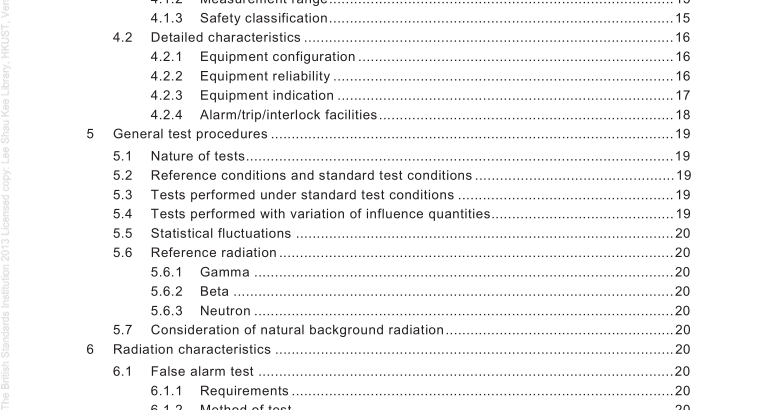BS IEC 60532:2010 pdf download – Radiation protection instrumentation — Installed dose rate meters, warning assemblies and monitors — X and gamma radiation of energy between 50 keV and 7 MeV
4 Design requirements
4.1 General characteristics
4.1.1 Overview Equipment may be designed as a single assembly (monitoring assembly) with the detector assembly adjacent to or contained within the monitoring assembly or the detector remote from the remaining equipment. The detector assembly (detector and associated electronics) may be located remotely from any processing assembly (electronics) and the indication and alarm assembly. It is desirable that all these options are provided by a single common design of equipment, and for the design to allow for the use of alternative types of detectors with the same indication and alarm assemblies.
4.1.2 Measurement range The equipment shall measure the dose rate due to X or gamma rays over an energy range of at least 80 keV to 1 ,5 MeV. Effective response to energies outside this range down to 50 keV and up to 7 MeV may be specified. The range of the equipment shall be at least three orders of magnitude of dose rate; five or more orders of magnitude may be required in some applications.
4.1.3 Safety classification The equipment covered in this standard is intended primarily for the purpose of radiological protection and, as defined in 5.3 of IEC 61 226:2009 may be installed in facilities such as nuclear power plants, nuclear fuel storage and processing sites, and thus may play a role in the achievement or maintenance of nuclear power plant safety. For example, if the signals are used for initiating protective action to mitigate the consequences of malfunction or failure of structures, systems or components, then the equipment shall be considered as part of the safety-related systems or the protection system. In this case, it shall meet the requirements of the respective system. If a safety classification applies, appropriate requirements shall apply concerning specification, design, manufacturing, installation and operation of the equipment with respect to the quality of hardware and software. The requirements shall be agreed between the manufacturer and the purchaser. In particular, the purchaser shall decide the appropriate safety standard applicable to the site in which the system will function, i.e. either IEC 61 51 3 or in the IEC 61 508 series.
Compliance with IEC 61 51 3 is required for monitors used in nuclear power plants. The basic safety standards that comprise IEC 61 508 may apply as well as they have been interpreted for the nuclear industry, and may be selected in some specific cases by agreement between the manufacturer and the purchaser. When the IEC 61 508 series is selected, the requirements of that series shall apply as appropriate to the required safety integrity level (SIL) specified for the system. Additionally, in such safety related protection system applications, equipment shall be environmentally qualified in accordance with the requirements of IEC 60780. When applicable, equipment shall be seismically qualified in accordance with the requirements of IEC 60780.
NOTE 1 It is anticipated that the SIL for equipment intended for the purpose of general area radiological protection will be SIL 1 . In cases where the equipment is intended to act as an interlock in a safety related protection system(s), such as personnel access control systems which prevent human access to areas which can be subject to very high radiation fields, it is anticipated that the SIL for equipment will be SIL 2 or 3.
NOTE 2 The final choice between IEC 61 51 3 and the IEC 61 508 series will be agreed between purchaser and manufacturer. As an indication, the following correspondence is given:
– Cat. A -> SIL 3
– Cat. B -> SIL 2
– Cat. C -> SIL 1
4.2 Detailed characteristics
4.2.1 Equipment configuration
The type of equipment defined in this standard generally comprises up to four types of assemblies, which may be interconnected in a number of configurations.
These assemblies are
– detector assembly (DA),
– processing assembly (PA),
– alarm assembly (AA),
– monitoring assembly (MA).
